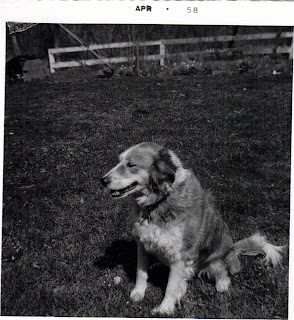 |
| Baxter with his dog-chew |
I showed his picture to my wife, and she did not hesitate: we had to bring him home with us. And so we did.
The first thing we did was rename him "Baxter." Don't quite know why. But it seemed to fit.
Baxter was one of the sweetest dogs we had ever seen. Completely untrained, but a quick learner, easily housebroken within day or two. I worked with him on his leash training, so that he'd walk at my left knee. I like to speed up and slow down when leash training, so the dog learns to put his trust in me and match my pace. I also come to a full stop before crossing any street, and even at irregular times. Sometimes I zig and zag, or do a 180 and change direction completely. And so Baxter learned to always focus on what I'm doing.
He had an endearing habit of lying at our feet (or on top of them!), whether we were in the living room reading or watching TV or in the kitchen fixing a meal (so that we had to step over him between the sink and the stove). It was a big change from our more-aloof Shauna. Whereas Shauna was more wolfish in her behavior, always friendly with everybody but preferring to be alone in another room and not at all cuddly, Baxter was a real dog in every sense of the word. He loved to lie on his back in the grass, legs splayed and a grin on his face. Whereas Shauna sipped her water carefully and never spilled a drop, Baxter was an enthusiastic drinker, splashing water around his bowl and then dripping it from his muzzle afterward, leaving a trail of water across the kitchen floor. Another endearing habit, to us.
We wanted to adopt Baxter, but with his being only a year old and we being in our sixties (Really? How did that happen?), we were concerned about his long-term care. Of course, everybody shares life's unpredictability, regardless of age. But one's own passing becomes more predictable with age. In the end, after being lucky enough to have had Baxter for three months, and with his recovery from his leg surgery, we reluctantly returned him to the Animal Care Center. But not without printing up an information paper about him: how to continue his training; his habits; his allergy to grains (requiring a limited ingredient dog food-- Natural Balance venison and sweet potato worked great); his exercise program; and other such details. This was made available to any potential adopting family. Two days later, I received an email from the shelter: Baxie had been adopted on the very first day! By a good family, who were serious enough about his care to request his medical records for their own vet.
As my wife put it, Baxter's absence left a hole in her heart. Happy at the storybook ending, but still missing him. It's almost like sending a son or daughter away to college, except that we'll never see Baxie again. Selfish? Selfishness is sometimes the Siamese twin of sadness.
 |
| Shauna and Baxter with toy rabbit |
 |
| Hey, this is my towel! |
 |
| Hey, this TV show is about dogs! |
 |
| Ah, this is the life! |
 |
| If nobody's using this sofa, I'll just stretch out a bit. |



















